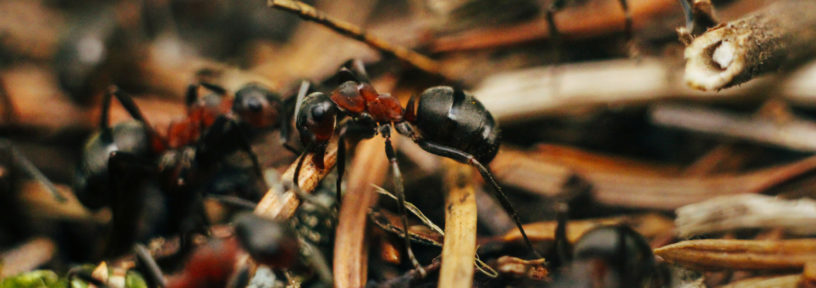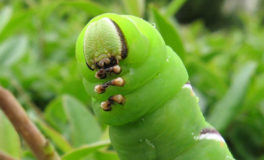How to control turf pests – Having a great looking lawn and garden is really important, especially if you’ve been caring for it constantly, trying to keep that lush and vibrant feeling. However, there are always those little things working against you. And by “little things”, we mean all of those annoying pests that pop up in your garden, ruining the pristine lawn that you’ve been working on.
With everything from Earthworms to Aphids, these little critters can be very troublesome. They will damage the grass, mess up the plants and just generally turn your garden into a shadow of its former self.
Naturally, you’ll want to either get rid of these garden pests or at least keep them under control. That’s why we have put together this guide, just for you! Take a look at our guide on how to start protecting your garden today using TurfOnline’s range of pest control products, including the best-selling Fungus Fighter Plus.
How to control turf pests – Earthworms
What are Earthworms?
Earthworms are insects shaped like a thin tube that live within the soil and feed on organic matter. Earthworms can leave small mounds within your lawn; however, they are doing much more good than bad. They are known to enrich, aerate, relieve compaction and decompose soil.
Therefore, when it comes to Earthworms, we do not see them as lawn pests as the pros easily outweigh the cons.
What time of year are Earthworms common?
Due to Earthworms struggling to move in dry conditions, they tend to stay in a location until the soil becomes wet. Therefore, there tend to be more Earthworm sightings during wet weather.
What are the signs of Earthworms in your lawn?
- When mowing the lawn, if Earthworms are caught in the cutting it can cause swearing on the grass.
- As mentioned above, they will leave small mounds in the soil.
How to treat & prevent Earthworms in your turf?
As we discussed earlier, the worm is not much trouble and will actually help your lawn to be healthier. However, when it rains and the Earthworms come up to the ground, it is likely to attract birds to your grass.
How to control turf pests – Leatherjacks
What are Leatherjackets?
A Leatherjacket is larval before becoming a Crane fly (more commonly known as a daddy longlegs). The Crane fly will lay eggs in the lawn, producing Leatherjackets. This is a natural cycle and certainly nothing to be concerned about.
What time of year are Leatherjackets common?
Leatherjackets lend to be produced when the ground is not frozen, which is typically between February and October.
What are the signs of Leatherjackets in your lawn?
- If you have an increase of Crane Flies (daddy longlegs) around your garden, it is likely that they have been producing Leatherjackets.
- Patches that are drier than the rest of the lawn. This is due to the lawn being peeled away from the soil.
- In extreme cases, there is the possibility that a lawn can become very patchy and dry.
How to treat & prevent Leatherjackets in your turf?
To prevent the extreme condition where Leatherjackets cause patches and dry areas in your lawn has proven to be difficult. This is due to there being no chemical controls available. However, this is a way to help exterminate them from your garden.
Birds will come down to eat Leatherjackets and Crane flies although they may irritate your lawn a little bit; however, they will be helping. It can also help to cover dry areas of your lawn with black polythene overnight. This will encourage the leatherjackets to the surface of the lawn. It is important to know that once the larvae have hatched, they crane flies will move on.
How to control turf pests – Frit Flies
What are Frit Flies?
A Frit Fly is around 2-3mm in length with a black, shiny body. Frit Flies, if in large quantities can be harmful to a lawn. Particularly dangerous when developing as larva because they drill their way through the grass stems and cause colourless growth and patchy areas.
What time of year are Frit Flies common?
Adult Frit flies around autumn time, allowing the larvae to develop throughout winter. Next, the larvae pupate in the spring and emerge as adults around Easter.
What are the signs of Frit Flies in your lawn?
- Seedlings will become weak.
- Patchy and colourless areas in the lawn.
- Slower grass growth
How to treat & prevent Frit Flies in your turf?
In order to treat Frit Flies, we would recommend spraying the areas that are showing poor and patchy growth with a pesticide that has chlorpyrifos.
In order to find out if your turf is infected by Frit Flies, is by placing a plain white piece of paper on your lawn. Frit Flies are attracted to white objects. Aerating your lawn will also help when trying to prevent Frit Fly larvae. To find out more about how to aerate your lawn, click here!
Products that can help…
 |
 |
How to control turf pests – Ants
What are Ants?
Ants are similar to worms, if you notice ants within your lawn, you shouldn’t worry too much as they cause little to nothing in terms of problems. Ants come in large colonies and infact benefit your grass! For example, Ants protect plants for diseases and exterminate pests. However, in extreme cases, ants can cause soil mounds at the opening of their nests. Although, these are typically small and not too noticeable.
What are the signs of Ants in your lawn?
- An increase in flying ants around your garden. This could mean that there is a nest.
- Small volcano-shaped mounds.
What time of year are ants common?
Ants typically cluster in August and are most active between April to October.
How to treat & prevent ants in your turf?
In general, it is recommended that you leave any ants’ nests alone, no matter where in your garden they are. This is because it can actually lead to a much larger problem as the ants will need to create and build new nests elsewhere.
However, there are times when you really do need to take action. For example, if you find that there are ants’ nests in your house or they are getting far too large, then you can use chemicals to solve the issues. Most of these chemicals are suitable for indoor use and come as powders or gels.
It is important to note, however, that you shouldn’t use these chemicals near plants and definitely not directly on them. Doing so can seriously harm your plants!
Aphids
What are Aphids
Aphids (also known as Greenflies) are a tiny green insect that can cause problems to your lawn if found in large numbers. Small numbers typically do not do much damage; however, a large number can cause loss of colour in the grass. This is due to the honeydew, which is a sticky substance that is deposited by the Aphids.
What are the signs of aphids in your lawn?
- Sticky Grass
- Yellow/Brown patches in the lawn.
- Stunted growth in plants nearby
- Discoloured leaves/
- Visible sightings of green insects.
What time of year are aphids common?
Typically, Aphids are most common between March to September.
How to treat & prevent aphids in your turf?
It may surprise you to learn that aphids are actually really low in the insect food chain! For example, everything from ladybirds to wasps will feast on them. In fact, a previously mentioned pest also eats aphids for dinner; ants. Therefore, the population of aphids is typically kept under control by these insectoid predators.
With that said, there is always the chance that the number of aphids in your garden will increase exponentially. After all, these little pests can multiply at an extremely rapid rate, meaning that the local aphid population can quickly become out of control.
If this is the case, then the swiftest method to get the aphids back under control is through the use of chemical pesticides. The majority of these will come in the form of a spray which you should use to coat all of the affected leaves. Make sure that you also spray the underside of the affected leaves as well!
Doing this will help to bring down your local aphid population, protecting your garden and keeping it nice and healthy.
Chafer Grubs
What are Chafer Grubs?
As the name “grub” suggests, Chafer Grubs are larvae insects similar to Leatherjackets. They eat and damage the roots of your grass, causing your garden to lose its lush feel. On top of this, because Chafer Grubs are larvae, that also means that they are the infant (or larval) stage of the Chafer Beetle.
Most gardens will have a small number of chafer grubs, which isn’t really an issue. These pests only really become a problem when they cause damage to your lawn over time or grow in number. At that point, you’ll need to take action in order to protect your garden.
Products that can help…
 |
 |
What are the signs of Chafer Grubs in your lawn?
- Patches in your lawn, typically yellow or brown in colour.
- Sections of the lawn become very dry and can be peeled away from the soil.
- When checking under the lawn, a large number of grubs can be found in the soil.
- Please note that Chafer Grubs are around 1.5cm long and feature a cream body with an orange head. Knowing this will help you to differentiate them from Leatherjackets.
- If there is a large number of adult Chafer Beetles in your garden around May or June, this is generally a good warning sign that you’ll have issues in the near future.
What time of year are Chafer Grubs common?
You’ll usually find Chafer Grubs appearing between May and August.
How to treat & prevent Chafer Grubs in your turf?
When it comes to Chafer Grubs, they really do have a lot in common with Leatherjackets. For example, there really isn’t a lot you can do in terms of preventing a rise in Chafer Grubs. Instead, you have to deal with them once they have appeared.
To do this, you should start by peeling back any damaged sections of your lawn to locate and remove any of the larvae that you can see. From there, you can actually let the birds have a field day as they are great for natural pest control. On top of this, using a parasitic nematode called “Heterorgabditis megidis”, you will be able to specifically target Chafer Grubs.
Using this type of biological treatment, you will easily be able to kill off the Chafer Grubs that have infested your garden. The fact that these treatments are available at garden centres makes this even easier! Just make sure you read and follow the instructions on the box.
Finally, once you have gotten rid of the grubs that are already there, you can start scarifying and aerating your garden. That will help to minimise any future appearance of Chafer Grubs.
How do we look after our turf at Harrowden?
When it comes to Harrowden Turf, we take huge pride in our farms. As such, we are very careful to keep our turf healthy and strong, with pests kept under control. However, what we don’t do is shower our crops in pesticides!
Our farm has been carefully designed and grown to be part of a natural ecosystem. We do our very best to make sure that the grass is healthy and lush, whilst the soil, worms and microbes living around the farm are in the best possible heart. All of this comes together to help us grow some of the best quality turf out there.
Keeping everything in balance like this means that, whilst you may see the very occasional larvae or beetle, our turf remains of the highest quality.
Should you control turf pests or refresh your garden?
Well, now you know all about the most common garden pests that you could find here in the United Kingdom. Not only that, but we have also covered how to keep these pests under control so that your lawn and garden are protected.
However, if you find that it is already too late for some sections (or all) of your garden, then perhaps you need to take a different approach. For example, if your lawn is already severely damaged or covered in patches, it might actually be a better option to refresh your garden entirely.
Doing this would first involve removing the current pests that have damaged your lawn. From there, the simplest method to refresh your garden is to lay new turf. By laying turf, you can help to revitalise your garden and give it a new lease of life. So why not take a look at our turf and see whether it is the right thing for your garden!

 Common lawn pests and how to deal with them
Common lawn pests and how to deal with them 

